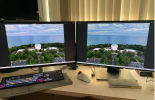I brought home a new 4k monitor today that I got on open box special, a Dell s2721QS. I'm not sure if I'm going to keep it, but want to give it a shot. [Contemplating exchanging it for an ASUS ProArt 27"]. I have it running in parallel to my older 27" Dell FHD which I've liked a lot but eyeball comparisons are difficult to judge. So out came the i1Profiler Colorimeter by Xrite.
It's been a LONG time since I used my colorimeter and had it set for what is probably an old standard for photos. When I pulled up the program the targets were 300cd/ms and 6500°K. I suspect with the proliferation of 4k video those target numbers might have changed. I'm seeing some yellows that I've not been seeing in my other monitors, but haven't calibrated those in a long time- if ever. But I would have suspected the yellows if the color temp had been set to D5000.
Is there anyone who can confirm those calibration settings or can tell me what the new "modern" targets are? To my eye the calibrated screen looked lower in brightness and contrast than I'm used to looking at so I'm speculating that 300cd/ms is a little low and this monitor might just be showing color that the older and less expensive monitors aren't capable of. I know that years ago I had a very expensive monitor that wanted to be warmer than all my others. I want to confirm that the monitor isn't the problem. That Asus ProArt is intriguing, but is the quality additional $250 better?
Thoughts?
It's been a LONG time since I used my colorimeter and had it set for what is probably an old standard for photos. When I pulled up the program the targets were 300cd/ms and 6500°K. I suspect with the proliferation of 4k video those target numbers might have changed. I'm seeing some yellows that I've not been seeing in my other monitors, but haven't calibrated those in a long time- if ever. But I would have suspected the yellows if the color temp had been set to D5000.
Is there anyone who can confirm those calibration settings or can tell me what the new "modern" targets are? To my eye the calibrated screen looked lower in brightness and contrast than I'm used to looking at so I'm speculating that 300cd/ms is a little low and this monitor might just be showing color that the older and less expensive monitors aren't capable of. I know that years ago I had a very expensive monitor that wanted to be warmer than all my others. I want to confirm that the monitor isn't the problem. That Asus ProArt is intriguing, but is the quality additional $250 better?
Thoughts?
Last edited:










